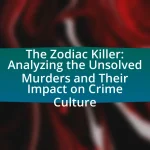The Black Dahlia case refers to the unsolved murder of Elizabeth Short, whose mutilated body was discovered in Los Angeles on January 15, 1947. This article explores the circumstances of Short’s life, the details of her gruesome murder, and the extensive media coverage that has contributed to the case’s infamy. It examines the challenges faced by investigators, the various theories and suspects that have emerged over the decades, and the impact of modern forensic advancements on the investigation. Additionally, the article discusses the connections between the Black Dahlia case and other unsolved murders, as well as practical steps for further investigation and resources for amateur sleuths interested in the case.

What is the Black Dahlia case?
The Black Dahlia case refers to the unsolved murder of Elizabeth Short, an American woman who was found dead in Los Angeles on January 15, 1947. Short’s body was discovered mutilated and severed in two, leading to widespread media coverage and public fascination. The case remains one of the most infamous unsolved murders in American history, with numerous theories and suspects proposed over the decades, yet no one has been definitively charged. The extensive investigation and media attention surrounding the case have contributed to its lasting legacy in popular culture and true crime discourse.
Who was Elizabeth Short, the Black Dahlia?
Elizabeth Short, known as the Black Dahlia, was an American woman who became a posthumous cultural icon following her brutal murder in Los Angeles in 1947. Short was born on July 29, 1924, in Hyde Park, Massachusetts, and moved to California in the early 1940s. Her murder, characterized by its gruesome details and the media frenzy it generated, remains one of the most famous unsolved cases in American history. The name “Black Dahlia” was coined by the press, inspired by a film noir and her penchant for wearing black clothing. The case has led to numerous theories and investigations, but no one has been definitively charged with her murder.
What were the circumstances surrounding her life before her death?
Elizabeth Short, known as the Black Dahlia, lived a tumultuous life marked by instability and personal struggles before her death. She moved frequently between cities, including Boston and Los Angeles, often seeking work as an actress and struggling with financial difficulties. Short had a troubled childhood, with her father abandoning the family, which contributed to her search for love and acceptance. Her relationships with men were often complicated, and she was known to have been involved with several individuals in the months leading up to her murder. These circumstances of instability, emotional turmoil, and transient living contributed to the environment surrounding her life before her tragic death in January 1947.
How did Elizabeth Short become known as the Black Dahlia?
Elizabeth Short became known as the Black Dahlia due to the media’s sensational coverage of her murder in 1947, which included the nickname. The term “Black Dahlia” was coined by the press, likely inspired by the film “The Blue Dahlia,” which was popular at the time, and her preference for wearing dark clothing. This nickname became synonymous with her identity following her brutal death, which was characterized by its gruesome details and the mystery surrounding it, leading to widespread public fascination and speculation.
What are the key details of the Black Dahlia murder?
The Black Dahlia murder refers to the unsolved homicide of Elizabeth Short, a 22-year-old woman found dead in Los Angeles on January 15, 1947. Short’s body was discovered mutilated and severed in two, with extensive lacerations and her mouth cut from ear to ear, leading to widespread media coverage and public fascination. The case remains one of the most infamous unsolved murders in American history, with numerous suspects and theories proposed over the decades, yet no one has been definitively charged. The investigation was marked by sensationalism and numerous false leads, contributing to its enduring mystery.
When and where was Elizabeth Short found?
Elizabeth Short was found on January 15, 1947, in Leimert Park, Los Angeles, California. Her body was discovered in a vacant lot, and the case remains one of the most infamous unsolved murders in American history.
What were the details of the crime scene?
The crime scene of the Black Dahlia, identified as Elizabeth Short, was located in Leimert Park, Los Angeles, on January 15, 1947. The body was discovered severed in half, with the lower half positioned a foot away from the upper half, and the body was drained of blood, indicating a meticulous killer. The scene also revealed extensive mutilation, including facial lacerations and the removal of organs, which suggested a level of surgical skill. Additionally, the body was posed in a way that indicated a deliberate attempt to shock and draw attention, as evidenced by the positioning of the limbs and the facial expression. These details highlight the brutality and calculated nature of the crime, contributing to the ongoing intrigue and investigation surrounding the case.
Why is the Black Dahlia case considered unsolved?
The Black Dahlia case is considered unsolved due to the lack of definitive evidence identifying the murderer and the numerous theories that have emerged without conclusive proof. Elizabeth Short, known as the Black Dahlia, was found murdered in Los Angeles in January 1947, and despite extensive investigations, no one was ever charged with her murder. The case remains open, with various suspects proposed over the years, but none have been definitively linked to the crime, leaving it a mystery that continues to intrigue and baffle investigators and the public alike.
What challenges did investigators face during the initial investigation?
Investigators faced significant challenges during the initial investigation of the Black Dahlia case, primarily due to a lack of physical evidence and the overwhelming media attention. The crime scene was compromised as numerous individuals, including curious onlookers and reporters, invaded the area before forensic teams could secure it, leading to the loss of crucial evidence. Additionally, the investigation was hindered by the absence of reliable witnesses, as many potential witnesses provided conflicting accounts, complicating the pursuit of leads. The intense media scrutiny further complicated the investigation, as sensationalized reporting often led to public misinformation and pressure on law enforcement to produce quick results.
How has the case remained open for decades?
The case of the Black Dahlia has remained open for decades due to a combination of insufficient evidence, lack of credible leads, and the complexity of the investigation. Despite extensive media coverage and numerous theories, law enforcement has not been able to conclusively identify a suspect or determine the circumstances surrounding Elizabeth Short’s death. The original investigation faced challenges such as the destruction of key evidence and the passage of time, which has led to the case being classified as unsolved. Additionally, the enduring public interest and the emergence of new forensic techniques have kept the case alive in the public consciousness, prompting ongoing discussions and occasional re-examinations by law enforcement.

What new theories have emerged regarding the Black Dahlia case?
New theories regarding the Black Dahlia case suggest that the murder may have been linked to a serial killer or involved organized crime. Recent investigations have proposed that George Hodel, a physician, could be the prime suspect due to circumstantial evidence, including his connection to the Los Angeles area and his alleged confession to the crime. Additionally, some researchers have explored the possibility that Elizabeth Short, known as the Black Dahlia, was involved in a love triangle that led to her murder, implicating multiple individuals. These theories have gained traction as new forensic techniques and historical analyses have emerged, allowing for a reevaluation of the evidence surrounding the case.
How do modern theories differ from original investigations?
Modern theories about the Black Dahlia case differ from original investigations primarily in their reliance on advanced forensic techniques and interdisciplinary approaches. Original investigations focused on eyewitness accounts and physical evidence available at the time, which were limited by the technology of the 1940s. In contrast, modern theories utilize DNA analysis, digital forensics, and psychological profiling, allowing for a more comprehensive understanding of the crime. For example, recent studies have employed genealogical DNA testing to explore potential suspects, a method not available during the original investigation. This evolution in methodology enhances the accuracy and depth of analysis, leading to new insights into the case.
What role do forensic advancements play in new theories?
Forensic advancements play a crucial role in developing new theories about unsolved cases, such as the Black Dahlia murder. These advancements, including DNA analysis, digital forensics, and improved crime scene investigation techniques, enable investigators to re-examine evidence with greater accuracy and detail. For instance, advancements in DNA technology allow for the identification of potential suspects from minute biological samples that were previously unusable, thereby opening new avenues for investigation. Additionally, the application of digital forensics can uncover previously overlooked digital footprints, providing context and connections that may lead to new theories. The integration of these modern forensic methods has led to a reevaluation of existing evidence, fostering innovative hypotheses about the circumstances surrounding the Black Dahlia case.
Which suspects have been proposed in recent theories?
Recent theories regarding the unexplained death of the Black Dahlia have proposed several suspects, including George Hodel, a physician who was investigated due to circumstantial evidence linking him to the crime, and his son, Steve Hodel, who has published books asserting his father’s guilt. Additionally, other suspects mentioned in recent discussions include Leslie Dillon, a bellboy who had connections to the victim, and the infamous serial killer, Richard Ramirez, although evidence for these claims remains largely speculative. These suspects have emerged from a combination of historical analysis and new interpretations of existing evidence, reflecting ongoing interest in the case.
Why do some believe the Black Dahlia case is linked to other murders?
Some believe the Black Dahlia case is linked to other murders due to similarities in the modus operandi and victim profiles. For instance, the brutal nature of Elizabeth Short’s murder in 1947 shares characteristics with other unsolved homicides in Los Angeles during that era, such as the murders of Mary Ann Nichols and other victims attributed to the so-called “Black Dahlia Avenger.” Additionally, the geographic proximity and timing of these murders suggest a potential serial killer operating in the area. Investigators and true crime enthusiasts often point to these patterns as evidence of a broader series of crimes connected to the Black Dahlia case.
What similarities exist between the Black Dahlia case and other unsolved murders?
The Black Dahlia case shares several similarities with other unsolved murders, particularly in the aspects of media sensationalism, public fascination, and the presence of multiple suspects. Like many high-profile unsolved cases, the Black Dahlia murder of Elizabeth Short in 1947 attracted extensive media coverage, which often led to the dissemination of misinformation and speculation, a phenomenon also observed in cases such as the Zodiac Killer and JonBenét Ramsey. Additionally, both the Black Dahlia case and other unsolved murders often involve a lack of conclusive evidence, leaving law enforcement with numerous theories but no definitive answers. The involvement of various suspects, as seen in the Black Dahlia case where numerous individuals were considered, is a common thread in many unsolved murders, complicating investigations and prolonging the mystery.
How have these connections influenced public perception of the case?
The connections between the Black Dahlia case and various suspects have significantly influenced public perception by creating a narrative that intertwines mystery with intrigue. These associations have led to widespread speculation and fascination, as individuals often gravitate towards sensational theories that involve high-profile figures or unsolved crimes. For instance, the involvement of notable suspects, such as George Hodel, has fueled theories that suggest a cover-up or conspiracy, which captivates public interest and shapes opinions about the case’s complexity. This phenomenon is evident in media portrayals and popular culture references, which often emphasize these connections, thereby reinforcing the belief that the case remains unresolved and enigmatic.

What evidence has been re-examined in the Black Dahlia case?
In the Black Dahlia case, evidence that has been re-examined includes the original autopsy reports, crime scene photographs, and forensic evidence such as hair and fiber samples. Recent advancements in forensic technology, particularly DNA analysis, have prompted law enforcement and researchers to revisit these materials to seek new insights into the unsolved murder of Elizabeth Short. The re-examination aims to identify potential suspects and clarify details surrounding the case, which has remained open since 1947.
What forensic evidence has been revisited in recent years?
Recent years have seen a revisitation of forensic evidence related to the Black Dahlia case, particularly DNA analysis of biological samples. Advances in DNA technology have allowed forensic experts to re-examine evidence such as hair and tissue samples collected from the crime scene. For instance, a 2021 study utilized mitochondrial DNA analysis on hair strands found with the victim, which had previously been deemed inconclusive. This new approach aims to potentially identify the perpetrator or provide more clarity on the circumstances surrounding Elizabeth Short’s death.
How has DNA technology impacted the investigation?
DNA technology has significantly impacted investigations by providing a reliable method for identifying individuals involved in crimes. In the context of the Black Dahlia case, advancements in DNA analysis could potentially link biological evidence from the crime scene to specific suspects, thereby narrowing down the list of possible perpetrators. For instance, DNA profiling has been shown to solve cold cases by matching genetic material found at crime scenes with databases of known offenders, leading to breakthroughs in previously unsolvable cases. This technology enhances the accuracy of forensic evidence, making it a crucial tool in modern criminal investigations.
What new findings have emerged from re-examined evidence?
New findings from re-examined evidence in the case of the Black Dahlia indicate potential connections to a serial killer active in Los Angeles during the 1940s. Forensic analysis of previously overlooked photographs and witness statements has revealed inconsistencies in the original investigation, suggesting that Elizabeth Short may have been targeted due to her associations with influential individuals. Additionally, advancements in DNA technology have allowed for the re-evaluation of biological samples collected at the crime scene, which may link the murder to other unsolved cases. These findings challenge previous assumptions and open new avenues for investigation into the circumstances surrounding Short’s death.
What role do eyewitness accounts play in the Black Dahlia case?
Eyewitness accounts play a crucial role in the Black Dahlia case by providing initial leads and potential suspect descriptions. Numerous witnesses reported seeing Elizabeth Short, the victim, in the days leading up to her murder, which helped investigators piece together her last known movements. For instance, several individuals claimed to have seen her in various locations in Los Angeles, including bars and social gatherings, which contributed to the timeline of her final hours. However, the reliability of these accounts has been questioned due to inconsistencies and the chaotic nature of the investigation, leading to challenges in corroborating the information provided. Despite these issues, eyewitness testimonies remain a significant aspect of the case, influencing both public perception and investigative direction.
How reliable are the eyewitness testimonies from the time of the murder?
Eyewitness testimonies from the time of the Black Dahlia murder are generally considered unreliable due to factors such as memory distortion and the passage of time. Research indicates that eyewitness accounts can be influenced by stress, leading to inaccuracies in recall. A study published in the journal “Psychological Science” found that high-stress situations can impair memory accuracy, which is relevant given the chaotic circumstances surrounding the murder. Additionally, inconsistencies in eyewitness statements have been documented, further questioning their reliability.
What inconsistencies exist in the accounts provided by witnesses?
Witness accounts regarding the Black Dahlia case exhibit several inconsistencies, particularly in descriptions of the suspect and the timeline of events. For instance, some witnesses reported seeing a man with a dark coat and hat near the crime scene, while others described a lighter-colored outfit. Additionally, discrepancies arise in the timing of when witnesses claim to have seen Elizabeth Short alive, with some stating she was last seen days before her body was discovered, while others assert they saw her on the day of her murder. These conflicting details complicate the investigation and hinder the establishment of a clear narrative surrounding the events leading to her death.
What practical steps can be taken to further investigate the Black Dahlia case?
To further investigate the Black Dahlia case, law enforcement agencies can re-examine existing evidence, including forensic materials and witness statements. Advances in forensic technology, such as DNA analysis, could provide new insights into the case, as many physical pieces of evidence from the 1947 investigation remain untested with modern techniques. Additionally, reviewing and analyzing historical police reports and interviewing descendants of key witnesses may uncover new leads or perspectives. Engaging with cold case units and utilizing crowdsourcing platforms for public tips can also generate fresh information. Historical context, such as the social environment of Los Angeles in the late 1940s, can guide investigators in understanding potential motives and suspects.
How can modern investigative techniques be applied to cold cases?
Modern investigative techniques can be applied to cold cases through advancements in forensic science, data analysis, and technology. For instance, DNA analysis has revolutionized the ability to link suspects to crime scenes, even decades after the crime occurred. In the case of the Black Dahlia, re-examining evidence with contemporary DNA methods could potentially yield new leads. Additionally, digital tools such as geographic information systems (GIS) can help analyze patterns and connections in unsolved cases, while social media and online databases facilitate the gathering of new information from the public. These methods have been successfully utilized in various cold cases, leading to breakthroughs that were previously unattainable.
What resources are available for amateur sleuths interested in the case?
Amateur sleuths interested in the Black Dahlia case can access various resources, including books, documentaries, online forums, and investigative websites. Notable books such as “The Black Dahlia” by James Ellroy provide fictionalized accounts that spark interest, while non-fiction works like “Black Dahlia, Red Rose” by Piu Eatwell offer detailed analyses of the case. Documentaries, including “The Black Dahlia Murder” available on streaming platforms, present visual narratives and expert interviews. Online forums, such as Reddit’s r/UnsolvedMysteries, allow for community discussions and sharing of theories. Investigative websites, like the Black Dahlia Case website, compile evidence, timelines, and theories, serving as a hub for research and collaboration among amateur detectives.


